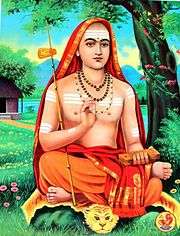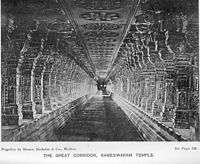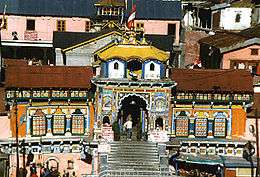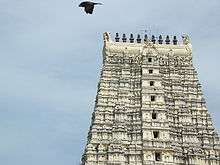Ramanathaswamy Temple
| Sri Ramanathaswamy Temple, Rameshwaram | |
|---|---|
|
| |
 Sri Ramanathaswamy Temple, Rameshwaram Location in Tamil Nadu | |
| Name | |
| Proper name | Sri Ramanathaswamy Thirukoil |
| Geography | |
| Coordinates | 9°17′17″N 79°19′02″E / 9.288106°N 79.317282°ECoordinates: 9°17′17″N 79°19′02″E / 9.288106°N 79.317282°E |
| Country |
|
| State | Tamil Nadu |
| District | Ramanathapuram |
| Location | Rameswaram |
| Culture | |
| Primary deity | Ramanathaswamy (Shiva) |
| Architecture | |
| Architectural styles | Dravidian architecture |
| History and governance | |
| Creator | Pandya and Jaffna kings |
| Char Dham
Dwarka • Puri |
|---|
Ramanathaswamy Temple is a Hindu Temple dedicated to the god Shiva located on Rameswaram island in the state of Tamil Nadu, India. It is also one of the twelve Jyotirlinga temples.It is one of the 274 Paadal Petra Sthalams, where the three of the most revered Nayanars (Saivite saints), Appar, Sundarar and Tirugnana Sambandar, have glorified the temple with their songs. The temple was expanded during the 12th century by Pandya Dynasty, and its principal shrines sanctum were renovated by Jeyaveera Cinkaiariyan and his successor Gunaveera Cinkaiariyan of the Jaffna kingdom. The temple has the longest corridor among all Hindu temples in India.[1] The temple is located in Rameswaram considered a holy pilgrimage site for Shaivites, Vaishnavites and Smarthas. The presiding deity, the Lingam of Ramanathaswamy (Shiva), is believed to have been established and worshiped by Rama, an avatar of the god Vishnu, to absolve the sins created during the Ramayana war at Sri Lanka.
Legend
According to the Ramayana, Rama, the seventh avatar of the god Vishnu, prayed to the god Shiva to absolve him of the sin of killing a brahmin, committed during his war against the demon king Ravana in Sri Lanka.[2][3] Rama wanted to have a large lingam to worship Shiva. He directed Hanuman, the monkey lieutenant in his army, to bring a lingam from the Himalayas. When Hanuman was delayed in bringing the lingam, Sita, the wife of Rama, built a small lingam out of the sand available in the sea shore, which is believed to be the lingam in the sanctum.[4]
Architecture
.jpg)
The primary deity of the temple is Ramanathaswamy (Shiva) in the form of lingam.[1] There are two lingams inside the sanctum - one built by Sita, from sand, residing as the main deity, Ramalingam and the one brought by Hanuman from Kailash called Vishwalingam.[4][5] Rama instructed that the Vishwalingam should be worshipped first since it was brought by Hanuman - the tradition continues even today.[5]
Like all ancient temples in South India, there is a high compound wall (madil) on all four sides of the temple premises measuring about 865 feet furlong from east to west and one furlong of 657 feet from north to south with huge towers (Gopurams) to the east and the west and finished gate towers to the north and south. The temple has striking long corridors in its interior, running between huge colonnades on platforms above five feet high.[6]
The second corridor is formed by sandstone pillars, beams and ceiling. The junction of the third corridor on the west and the paved way leading from the western gopuram to the Setumadhava shrine forms a unique structure in the form of a chess board, popularly known as Chokkattan Madapam, where the Utsava deities are adorned and kept during the Vasanthotsavam (Spring festival) and on the 6th day festival in Adi (July–August) and Masi (February–March) conducted by the Setupati of Ramnad.
The outer set of corridors is reputed to be the longest in the world, measuring about 6.9 m in height, 400 feet each in the east and west and about 640 feet in the north and the south. The inner corridors are about 224 feet each in the east and the west and about 352 feet each in the north and the south.[7] Their width varies from 15.5 feet to 17 feet in the east and west about 172 feet on the north and south with width varying 14.5 feet to 17 feet.[1][5][7] The total length of these corridors is thus 3850 feet. There are about 1212 pillars in the outer corridor.[7] Their height is about 30 feet from the floor to the center of the roof. The main tower or rajagopuram is 53 m tall. Most pillars are carved with individual compositions.[7] At the beginning, Ramanathaswamy Temple was a thatched shed. The present structure was the work of many individuals spread over a number of centuries. The pride of place in the establishment for the Temple goes to the Setupatis of Ramanathapuram. In the seventeenth century, Dalavai Setupati built a portion of the main eastern Gopuram. In late eighteenth century, the world famous third corridor was constructed by Muthuramalinga Setupati who lived for forty nine years and ruled between 1763 and 1795. The corridor was called “Chokkatan Mandapam”. The Mukhya Pradhani (Chief Minister) was Muthuirullappa Pillai and the Chinna Pradhani (Deputy Chief Minister) was Krishna Iyengar. The Setupati’s statue and those of his two Pradhanis (ministers) can be seen at the western entrance to the third corridor.
There are separate shrines for Ramanathaswamy and his consort goddess Parvathavardhini separated by a corridor.[6] There are separate shrines for the goddess Vishalakshi, the utsava images, sayanagriha, Vishnu and Ganesha. There are various halls inside the temple, namely Anuppu Mandapam, Sukravara Mandapam, Setupati Mandapam, Kalyana Mandapam and Nandi Mandapam.
Temple Tanks

There are sixty-four Tīrthas (holy water bodies) in and around the island of Rameswaram, Tamil Nadu, India.[8] According to Skānda Purāṇa, twenty-four of them are important.[9] Bathing in these Tīrthas is a major aspect of the pilgrimage to Rameswaram and is considered equivalent to penance.[10] Twenty-two of the Tīrthas are within the Rāmanāthasvāmī Temple.[11] The number 22 indicates the 22 arrows in Rama's quiver.[4] The first and major one is called Agni Theertham, the sea (Bay of Bengal).[1]
Significance today
Char Dham

The temple is one of the holiest Hindu Char Dham (four divine sites) sites comprising Badrinath, Puri and Dwarka.[12] Though the origins are not clearly known, the Advaita school of Hinduism established by Sankaracharya, who created Hindu monastic institutions across India, attributes the origin of Char Dham to the seer.[13] The four monasteries lie across the four corners of India and their attendant temples are Badrinath Temple at Badrinath in the North, Jagannath Temple at Puri in the East, Dwarakadheesh Temple at Dwarka in the West and Ramanathaswamy Temple at Rameswaram in the South. Though ideologically the temples are divided between the sects of Hinduism, namely Saivism and Vaishnavism, the Char Dham pilgrimage is an all Hindu affair.[14] There are four abodes in Himalayas called Chota Char Dham (Chota meaning small): Badrinath, Kedarnath, Gangotri and Yamunotri - all of these lie at the foot hills of Himalayas.[15] The name Chota was added during the mid of 20th century to differentiate the original Char Dhams. The journey across the four cardinal points in India is considered sacred by Hindus who aspire to visit these temples once in their lifetime.[16] Traditionally the trip starts at the eastern end from Puri, proceeding in clockwise direction in a manner typically followed for circuambulation in Hindu temples.[16]
Jyotirlinga
As per Shiv Mahapuran, once Brahma (the Hindu God of creation) and Vishnu (the Hindu God of saving) had an argument in terms of supremacy of creation.[17] To test them, Shiva pierced the three worlds as a huge endless pillar of light, the jyotirlinga. Vishnu and Brahma split their ways to downwards and upwards respectively to find the end of the light in either directions. Brahma lied that he found out the end, while Vishnu conceded his defeat. Shiva appeared as a second pillar of light and cursed Brahma that he would have no place in ceremonies while Vishnu would be worshipped till the end of eternity. The jyotirlinga is the supreme partless reality, out of which Shiva partly appears. The jyothirlinga shrines, thus are places where Shiva appeared as a fiery column of light.[16][18] Originally, there were believed to be 64 jyothirlingas of which 12 are considered to be very auspicious and holy.[17] Each of the twelve jyothirlinga sites take the name of the presiding deity - each considered a different manifestation of Shiva.[19] At all these sites, the primary image is the lingam representing the Stambha pillar, symbolizing the infinite nature of Shiva (without beginning or end).[19][20][21] The twelve jyothirlinga are Somnath in Gujarat, Mallikarjuna at Srisailam in Andhra Pradesh, Mahakaleswar at Ujjain in Madhya Pradesh, Omkareshwar in Madhya Pradesh, Kedarnath in Himalayas, Bhimashankar in Maharashtra, Viswanath at Varanasi in Uttar Pradesh, Triambakeshwar in Maharashtra, Vaidyanath at Deoghar in Jharkhand, Nageswar at Dwarka in Gujarat, Rameshwar at Rameswaram in Tamil Nadu and Grishneshwar at Aurangabad, Maharashtra.[17][22]
Historical pilgrimage
The temple is one of the most famous pilgrimage sites and has several historical references about it. The Maratha kings who ruled Thanjavur established chatrams or rest houses throughout Mayiladuthurai and Rameswaram between 1745 and 1837 CE and donated them to the temple.[23]
Temple contributions and donations from Hindu kings

The temple in its current shape is believed to have been built during the 17th century, while Fergusson believes the small vimana in the west corridor belongs to the 11th or 12th centuries.[6] The temple is said to have been sanctioned for construction by King Kizhavan Sethupathi or Raghunatha Kilavan. The contribution of the Jaffna kings of the Sethupathy dynasty to the temple was considerable.[5] King Jeyaveera Cinkaiariyan (1380 — 1410 CE) shipped stone blocks from Koneswaram temple, Trincomalee to renovate the temple's sanctum sanctorum. Jeyaveera Cinkaiariyan's successor Gunaveera Cinkaiariyan (Pararacacekaran V), a trustee at Rameswaram who also oversaw structural development of this temple and the promotion of Saivite beliefs donated part of his revenue to Koneswaram. Especially to be remembered are the immense sums that were spent during the tenure of Pradani Muthirulappa Pillai towards the restoration of the Pagodas which were falling into ruins and the splendid Chockattan Mantapam or the cloistered precincts of the temple at Rameswaram that he finally completed. The rulers of Sri Lanka also contributed to the temple - Parakrama Bahu (1153-1186 CE) was involved in the construction of the sanctum sanctorum of the temple.[5]
In News
The temple priests are Mahastra Brahmins who get Diksha from Sringeri Mutt.[24] A shortage of priests has been reported in recent years as there are only five priests to manage the 13 shrines within the temple.[24] The shortage is more pronounced during the 12-day Maha Shivaratri festival when the festival deities of the temple are taken in procession.[24] The temple comes under the renovation and consecration of the 630 temples planned by the Hindu Religious and Charitable Endowments Department of the Government of Tamil Nadu.[25] Temple authorities had planned to renovate and widen the pathways to the 22 holy theerthams of the temple.[25] The consecration of the temple was planned during 2013.[25] The temple is among those offering free meals under the Free Meals Scheme of the government, which provides meals to devotees of the temple. A pilgrim house is planned by the government to extend the scheme to more pilgrims.[25]
See also
Notes
- 1 2 3 4 Bhargava 2006, p. 396
- ↑ Jones 2007, p. 359
- ↑ Harshananda 2012, p. 115
- 1 2 3 Singh 2009, p. 18
- 1 2 3 4 5 Bandopadhyay ,pp. 88-89
- 1 2 3 Cole 1885, pp. clxvi-clxvii
- 1 2 3 4 T. 2007, p. 28
- ↑ Murali 2000, p. 574
- ↑ Setu Māhātmyam, Adhyāya 2, verse 104
- ↑ Setu Māhātmyam, Adhyāya 1, verse 24
- ↑ Seturaman 2001, p. 216
- ↑ Chakravarti 1994, p. 140
- ↑ Mittal 2004, p. 482
- ↑ Brockman 2011, pp. 94-96
- ↑ Mittal 2004, pp. 482-3
- 1 2 3 Gwynne 2008, Section on Char Dham
- 1 2 3 R. 2003, pp. 92-95
- ↑ Eck 1999, p. 107
- 1 2 Lochtefeld 2002, pp. 324-325
- ↑ Harding 1998, pp. 158-158
- ↑ Vivekananda Vol. 4
- ↑ Chaturvedi 2006, pp. 58-72
- ↑ M. 2003, p. 154
- 1 2 3 S.P. Loganathan 2012
- 1 2 3 4 Zee News 2012
References
- Mittal, Sushil (2004). The Hindu World. New York: Routledge. ISBN 0-203-64470-0.
- Jones, Constance (2007). Encyclopedia of Hinduism. New York: Infobase Publishing. ISBN 978-0-8160-5458-9.
- Bandopadhyay, Manohar (2010). Tourist destinations in India. Delhi: Oriental Books. ISBN 978-93-8094-400-5.
- Bhargava, Gopal K.; Shankarlal C. Bhatt (2006). Land and people of Indian states and union territories. 25. Tamil Nadu. Delhi: Kalpaz Publications. ISBN 81-7835-381-4.
- Brockman, Norbert C. (2011). Encyclopedia of Sacred Places. California: ABC-CLIO, LLC. ISBN 978-1-59884-655-3.
- Chaturvedi, B. K. (2006). Shiv Purana (First ed.). New Delhi: Diamond Pocket Books (P) Ltd. ISBN 81-7182-721-7.
- Chakravarti, Mahadev (1994). The Concept of Rudra-Śiva Through The Ages (Second Revised ed.). Delhi: Motilal Banarsidass. ISBN 81-208-0053-2.
- Cole, Henry Hardy (1885). Preservation of National Monuments - First Report of the Curator of Ancient Monuments in India for the year 1883-84. The Government Central Branch Press, Calcutta.
- Eck, Diana L. (1999). Banaras, city of light (First ed.). New York: Columbia University Press. ISBN 0-231-11447-8.
- Gwynne, Paul (2009). World Religions in Practice: A Comparative Introduction. Oxford: Blackwell Publication. ISBN 978-1-4051-6702-4.
- Harding, Elizabeth U. (1998). "God, the Father". Kali: The Black Goddess of Dakshineswar. Motilal Banarsidass. pp. 156–157. ISBN 978-81-208-1450-9.
- Harshananda, Swami (2012). Hindu Pilgrimage Centres (second ed.). Bangalore: Ramakrishna Math. ISBN 81-7907-053-0.
- Lochtefeld, James G. (2002). The Illustrated Encyclopedia of Hinduism: A-M. Rosen Publishing Group. p. 122. ISBN 0-8239-3179-X.
- M., Thangaraj (2003). Tamil Nadu: an unfinished task. SAGE. p. 170. ISBN 978-0-7619-9780-1.
- Murali, J. C. (2000). Tamizhaga Sivatalangal. Chennai: Chatura Padipakkam.
- R., Venugopalam (2003). Meditation: Any Time Any Where (First ed.). Delhi: B. Jain Publishers (P) Ltd. ISBN 81-8056-373-1.
- Setu Māhātmyam (Skānda Purāṇa Book 3:Chapter 1 (Bramha Khaṇḍa:Setu Māhātmyam) ).
- Seturaman, K (2001). Rameswaram Koil. Madurai: J. J. Publications.
- Singh, Sanjay (2009). Yatra2Yatra. Yatra2Yatra. p. 18. ISBN 978-81-908569-0-4.
- Singh, Sarina (2009). South India (Lonely Planet Regional Guide) (5th ed.). Lonely Planet. ISBN 978-1-74179-155-6.
- S.P. Loganathan (16 February 2012). "Shortage of priests at Rameswaram temple". Deccan Chronicle. Retrieved 19 February 2012.
- T., Ramamurthy (2007). Engineering In Rocks For Slopes Foundations And Tunnels (2bd ed.). Delhi: PHI Learning Private Limited. ISBN 978-81-203-3275-1.
- Vivekananda, Swami. "The Paris Congress of the History of Religions". The Complete Works of Swami Vivekananda. Vol.4.
- Zee News (20 February 2012). "Renovation & consecration completed in 630 temples". Zee News. Retrieved 19 February 2012.
External links
| Wikimedia Commons has media related to Ramanathaswamy Temple. |




